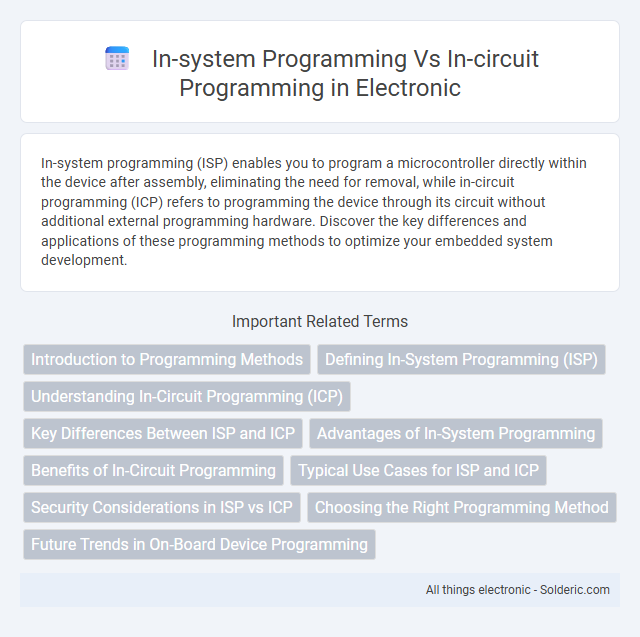In-system programming (ISP) enables you to program a microcontroller directly within the device after assembly, eliminating the need for removal, while in-circuit programming (ICP) refers to programming the device through its circuit without additional external programming hardware. Discover the key differences and applications of these programming methods to optimize your embedded system development.
Comparison Table
| Feature | In-System Programming (ISP) | In-Circuit Programming (ICP) |
|---|---|---|
| Definition | Programming a microcontroller or device within the final system without removal. | Programming a device directly on the circuit board with external programming hardware. |
| Programming Interface | Uses dedicated ISP pins or serial interfaces like SPI, I2C, UART. | Employs test access ports such as JTAG or dedicated ICP connectors. |
| Hardware Requirement | No removal needed; requires a compatible programmer and interface on the board. | External programmer connected to device test points or connectors on PCB. |
| Use Case | Firmware updates after assembly; field programming and debugging. | Initial programming during manufacturing and debugging through test points. |
| Advantages | Convenient, cost-effective, supports remote updates. | Reliable, precise control, supports boundary-scan testing. |
| Limitations | Requires specific ISP support in hardware and firmware. | Needs physical access to test points; may require special connectors. |
Introduction to Programming Methods
In-system programming (ISP) allows you to program a microcontroller directly within the assembled system without needing to remove the chip, facilitating updates and debugging. In-circuit programming (ICP) involves programming the microcontroller while it is mounted on the circuit board but requires a dedicated programming interface. Both methods streamline firmware deployment but differ mainly in accessibility and hardware requirements, making ISP more flexible for iterative development cycles.
Defining In-System Programming (ISP)
In-System Programming (ISP) enables microcontrollers to be programmed directly within the electronic system after being installed, eliminating the need for removal or separate programming devices. ISP allows firmware updates and modifications to be executed through a standard communication interface, enhancing development flexibility and reducing production costs. This method contrasts with In-Circuit Programming (ICP), which specifically refers to programming via dedicated pins while the device is embedded on a circuit board.
Understanding In-Circuit Programming (ICP)
In-Circuit Programming (ICP) enables direct programming of microcontrollers while they are embedded on a circuit board, eliminating the need to remove the chip from its system. This method uses dedicated programming interfaces and protocols like JTAG or SPI to access the microcontroller's memory and configuration registers in real time. Understanding ICP helps you streamline development and debugging by allowing firmware updates and testing without disrupting the hardware setup.
Key Differences Between ISP and ICP
In-system programming (ISP) occurs when a microcontroller or memory device is programmed within the complete system using dedicated programming interfaces, allowing updates without removing the chip. In-circuit programming (ICP) involves programming the device while it remains soldered on the circuit board but may require additional hardware connections or dedicated programming tools. The key differences lie in ISP's emphasis on seamless software updates via system interfaces versus ICP's focus on direct chip access through physical connections for initial programming or reprogramming.
Advantages of In-System Programming
In-System Programming (ISP) allows you to program microcontrollers or programmable devices directly within the final hardware setup, eliminating the need for removal and reducing production time. This method enhances flexibility by enabling firmware updates and debugging without disassembling the circuit, improving overall efficiency and reducing maintenance costs. ISP also supports automation in manufacturing environments, streamlining batch programming and ensuring consistent device configuration.
Benefits of In-Circuit Programming
In-circuit programming (ICP) offers significant advantages over in-system programming by enabling real-time debugging and testing directly on the hardware without removing the chip from the circuit. ICP allows for faster development cycles and error detection since programming and verification happen simultaneously within the device's operational environment. Your ability to modify or update firmware without disassembling the system reduces downtime and enhances overall efficiency during product development and maintenance.
Typical Use Cases for ISP and ICP
Typical use cases for In-System Programming (ISP) include updating firmware directly on microcontrollers embedded in final products, enabling software upgrades without removal from the circuit board, commonly found in consumer electronics and automotive applications. In-Circuit Programming (ICP) is often utilized during development and debugging stages to program and test microcontrollers while they remain on the development board or system, providing efficient real-time modifications for embedded systems. Understanding these use cases helps you choose the right programming method for manufacturing or iterative design processes.
Security Considerations in ISP vs ICP
In-system programming (ISP) offers enhanced security by allowing firmware updates without removing the chip, reducing physical access risks and potential tampering during reprogramming. In-circuit programming (ICP) often requires direct connection to the circuit, which may expose your device to unauthorized access if security protocols are not strictly implemented. Implementing robust encryption and access control is crucial in ISP to safeguard your device's integrity against cyber threats during remote or on-site programming.
Choosing the Right Programming Method
Choosing the right programming method depends on the specific application requirements and hardware constraints. In-system programming (ISP) allows programming the microcontroller while it is embedded within the complete system, offering convenience for firmware updates and debugging without removal. In-circuit programming (ICP) involves programming through dedicated hardware connections, typically requiring access to specific pins and potentially offering more control and reliability during the initial development and testing phases.
Future Trends in On-Board Device Programming
Future trends in on-board device programming emphasize seamless integration of In-system programming (ISP) and In-circuit programming (ICP) to enhance flexibility and reduce production costs. Advances in wireless and automation technologies are driving the development of more efficient, remote programming methods that minimize physical access requirements. Your ability to quickly update firmware directly on devices will become crucial as IoT and embedded systems continue to expand rapidly.
In-system programming vs In-circuit programming Infographic

 solderic.com
solderic.com